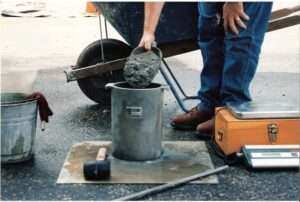Determine the Unit Weight of Concrete Test
In construction, we frequently need to make certain that the concrete we are the use of is just right. One critical aspect to recognise about concrete is its unit weight, which tells us how heavy it is in a given space. To discover this out, we use a test known as ASTM C138.
Why we Need Unit Weight of Concrete
The unit weight of concrete is a important parameter in production engineering for numerous reasons. Firstly, it plays a vital position in structural layout and evaluation. Knowing the unit weight enables engineers determine the overall weight of a structure, which is important for assessing its balance, load-bearing capacity, and ability influences on the muse.
Additionally, the unit weight of concrete is crucial for calculating the lifeless load on a structure. Dead load refers back to the static, non-transferring forces exerted by the load of the shape itself, along with the burden of concrete additives including beams, columns, and slabs. This facts is critical for designing foundations, choosing appropriate materials, and ensuring the structural integrity of the whole construction.
Moreover, in the course of the development section, understanding the unit weight of concrete is vital for logistical reasons. It helps in estimating the quantity of concrete wished for a assignment, which affects budgeting, scheduling, and aid planning.
What is Unit Weight?
Unit weight, placed certainly, refers back to the weight of a selected extent of concrete. It’s corresponding to inquiring about the weight of 1 cubic foot (or one cubic meter) of concrete. This measurement aids builders and engineers in verifying the strength and safety of the concrete employed for a selected undertaking.
Standard
ASTM C138 is a standard to check the measuring the density of freshly blended concrete.
Significance
The unit weight of clean concrete is an essential parameter inside the layout of structural elements. It influences the electricity, durability, and usual performance of the concrete. Determining the unit weight of sparkling concrete is critical in assessing the excellent of the combination and making sure that it meets the required specs.
Objective
The objective of this test is to determine the unit weight of clean concrete to assess its workability and estimate the quantity of substances required for a given volume of concrete.
Apparatus
- A cylindrical container
- A stability scale with a capacity of as a minimum 50 kg and a sensitivity of 0.1 kg
- Tamping rod
- Scoop
- Measuring cylinder
Theory
The unit weight of fresh concrete is the load of a given quantity of concrete, that is encouraged through various factors inclusive of blend design, combination kind and size, water-cement ratio, and air content material. To calculate the unit weight of concrete, you divide the burden of the concrete by the extent of the concrete.

Precautions for performing a unit weight test on Concrete
Here are the precautions for performing a unit weight test on concrete.
- Safety First:
- Wear appropriate PPE.
- Ensure good ventilation.
- Equipment Calibration:
- Regularly calibrate testing equipment.
- Sample Collection:
- Take representative samples.
- Handle samples carefully.
- Sample Preparation:
- Follow standard procedures.
- Avoid mix alterations.
- Testing Environment:
- Control temperature and humidity.
- Avoid extreme weather conditions.
- Correct Testing Procedure:
- Follow standard testing procedures.
- Set up apparatus correctly.
- Sample Saturation:
- Determine moisture content.
- Correct unit weight for moisture effects.
- Data Recording:
- Record all relevant information.
- Include source, mix design, and deviations.
- Quality Control:
- Implement quality control systems.
- Personnel Training:
- Ensure trained personnel conduct tests.
- Documentation:
- Maintain detailed documentation.
- Include any deviations encountered.
Procedure
- Before use, the cylindrical container undergoes cleaning and drying.
- The container is then weighed, and we denote the recorded weight as W1.
- We obtain a sample of fresh concrete and place it within the container in three layers, compacting each layer using the tamping rod.
- After filling the container, we level the surface of the concrete and remove any excess with the scoop.
- We then weigh the container with the concrete inside and identify the recorded weight as W2.
- Subsequently, we fill the box with water to a level just above the surface of the concrete, and we record the burden of the field, along side the water, as W3.
- We behavior the calculation of the unit weight of the fresh concrete the usage of the following formulation: We decide the unit weight of concrete as (W2 – W1) / (W3 – W1).
Calculation
- Weight of the container with concrete (W2) = ___________ kg
- Weight of the container (W1) = ___________ kg
- Weight of the container with water (W3) = ___________ kg
- Weight of fresh concrete (W2 – W1) = ___________ kg
- Volume of fresh concrete (W2 – W1) / unit weight of water = ___________ m3
- Unit weight of sparkling concrete = (W2 – W1) / (W3 – W1) = ___________ kg/m
Conclusion
Fresh concrеtе Thе unit wеight is an important factor in determining the bеst of thе concrеtе mixture. A small dеpеndablе tеchniquе is furnishеd by calculating the unit weight of pure concrеtе about looking at this which can bе utilizеd to assess the performance of thе mixturе and calculate the amount of substancеs rеquirеd for a given quantity of concrеtе.
Read More
Factor Affecting on Unit weight of concrete in lb/ft³, kg/m³
Unit Weight Of Construction Materials
Standard Proctor Test for Maximum Dry Density and Optimum Moisture Content of Soil
Concrete temperature of fresh concrete
Compressive strength test of concrete